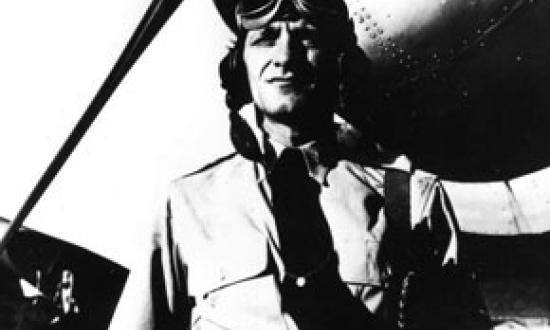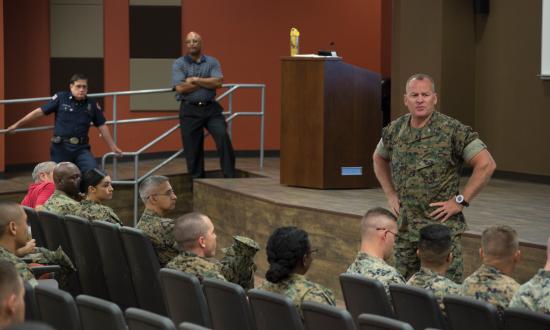Walk the passageways on any Navy ship or workspace, and you’ll likely be asked: “How are you?” If you’re like most, you may not provide an honest answer. Instead, you may reflexively reply with great, good, fine, or ok, demonstrating how people tend to steer around their genuine emotional states. Individual leaders must learn to recognize and deal with emotions; and if the Navy wishes to increase creativity, innovation, and retention, it must develop its leaders’ abilities to perceive, use, understand, and manage both their own emotional states and those of their followers.
The Problem
Emotions influence the way people think, work together, and, most importantly, make decisions. Despite this, they are often overlooked, misunderstood, and avoided. As a service, the Navy struggles to create space for self-awareness and emotional reflection—to engage with the question: “How are you feeling?” Some members of our force claim talking about emotions requires too much time and energy. Others argue emotions are disruptive, unproductive, and have no place in the military. They claim emotions are messy and touchy-feely.
Yes, navigating emotions is no simple task. The roller coaster of life sends our emotional states soaring high one moment and plunging deep the next. We can’t spend every minute focused on how we feel, or we would not have the bandwidth to do much else. Yet, the opposite approach is equally perilous: If we walk through life with emotional blinders, we risk missing critical cues from our mind, body, and the outside world that our brains rely on to process, analyze, and formulate our experience.1 Moreover, when we opt to avoid the work of understanding ourselves and those around us, we inevitably suppress or repress emotions. We too often attempt to move on without doing the work of engaging emotions, and as a result those emotions don’t go away. They get buried inside of us—accumulating—and prevent greater well-being, jeopardize relationships, and risk achievement of goals. Put simply, unprocessed emotions don’t dissipate, they metastasize.
Research shows that humanity at large is struggling emotionally. According to the 2019 World Happiness Report, negative feelings—including worry, sadness, and anger—have been steadily rising. Depression is now the world’s leading cause of disability. Diagnoses of major depression have risen 47 percent for the younger generation since 2013. Given the difficulties of 2020, including the COVID-19 pandemic and its attendant economic impacts, a significant increase to those statistics is likely in the near term. Military suicides, for example, increased as much as 20 percent compared to 2019, signaling that the Navy cannot expect immunity from the harsh realities of today. The need to seek integrative strategies to better understand how we lead and live in an unpredictable world has never been greater, especially if we want to increase creativity, innovation, and retention.
The Solution
To ensure resiliency through life’s unexpected curveballs, in addition to the many challenges of military life, the Navy must encourage leaders at all levels—from petty officers to flag officers—to recognize their emotions and afford the space to reflect upon them. The Navy must strive to develop people with the skills necessary to promote healthy thinking and productive actions and shift the focus on mental health from reactive to proactive. And those who say, “I’m not a therapist, I’m a warfighter, and I don’t need to attend to fears and feelings,” they are selling themselves short and underestimating one of the biggest threats to the Navy—problematic behaviors. So, we can either spend a reasonable amount of time attending to fears, feelings, and emotions or an unreasonable amount of time dealing with problematic behaviors. When put that way, the solution seems obvious. The Navy needs to be preventionist not interventionist.
Scientific research also validates the value of emotionally intelligent leaders.2 A recent Yale-led study of nearly 15,000 people across the U.S. workforce found that employees felt 50 percent more inspired and three times happier, as well as more creative and driven to find original ways of achieving work goals, when working for an emotionally intelligent leader.3 Moreover, their frustration levels were 30-40 percent lower, resulting in a lower burnout rate and significantly fewer individuals opting to leave their profession.4
Hence, understanding emotions is a critical first step toward creating a productive work culture. Unfortunately, we are not born with an innate talent for recognizing what we or others are feeling and why. Instead, we have to learn and develop it. Some individuals are more fluent than others when it comes to emotional matters. Nevertheless, emotions are essential to our character, and character development involves enhancing one's emotional inventory and capacity.5 We all have the responsibility to apply and model those behaviors to peers and subordinates alike. That is why leaders owe it to themselves and their teams to learn how to recognize, understand, label, express, and regulate emotions. Emotions work for us, not against us, because the cost of failing to deal in healthy ways with them is a steep bill the Navy cannot continue to pay.
A Measured Approach to Building Emotional Intelligence
To grow an emotionally stronger force, leaders need to be comfortable with having difficult conversations around a variety of topics, including, but not limited to, racism, sexism, family life difficulties, and other structural and interpersonal biases. Chief of Naval Operations Admiral Michael Gilday’s Message to the Fleet on race and relations in the Navy made it clear that “now is the time to have open and honest conversations across the Navy.” Emotional intelligence is essential to enabling those conversations. These discussions can be uncomfortable, but they’re required to ensure all voices are heard. Talking about tough topics requires work—a kind of work that demands emotional skills that are not gifted but acquired through education and exercise.
Marc Brackett, the director of the Yale Center for Emotional Intelligence, insists that understanding and mastering emotions is an integral part of education for leaders. He shares his RULER approach with organizations worldwide to instill five critical skills: recognizing our own emotions and those of others; understanding those feelings and determining the source; labeling emotions with nuanced vocabulary; expressing feelings in a productive manner; and regulating emotions instead of letting them regulate us.6 Brackett’s research shows how RULER skills can improve mental health, interpersonal relationships, and career performance. All of which are unequivocally positive outcomes, no matter what line of work you’re in, begging the question: If emotional intelligence is so necessary in the workplace, how are employees supposed to acquire it? In the Navy’s case, space must be made for the introduction and application of a RULER-like set of skills, within both enlisted and officer communities. Two of the most promising approaches are described below.
As soon as boot camp, sailors learn about their own emotional state in an effort to build mental toughness. An initiative called Warrior Toughness was established in 2018 by three key individuals, a chaplain, psychologist, and a SEAL at Recruit Training Command (RTC). This concept has been adapted and expanded by Naval Nuclear Power Training Command (NNPTC). The Warrior Toughness initiative teaches sailors to perform under pressure, take a hit and keep going, and excel throughout the “day-in and day-out grind.” The program teaches sailors how to recognize, understand, and accurately label their emotions. The evidence-based curriculum encompasses the whole person, mind, body, and soul. A sailor’s approach to mental preparation and enduring focus is derived from a strong sense of commitment, preparation, execution, and reflection. By introducing members of the force to the core teachings of affective psychology through applied exercises rooted in science, we can help sailors be as fit psychologically as they are physically. Research from RTC and NNPTC has shown that staff and students alike benefit from the techniques in both their work and personal lives.
The spread of Warrior Toughness teachings within the officer ranks is also vital. Officers influence others to accomplish the mission by providing vision, direction, purpose, and motivation. Officers’ emotional intelligence is a crucial ingredient for mission success as they must lead by example. Officers must continuously and quickly check their decisions and actions against the core values of the Navy and also within their own character. It’s complex and requires constant self-development. Instituting opportunities for officers to learn the importance of approaches such as the RULER technique must start when they join the Navy. Institutions such as Officer Development School, Officer Candidate School, the U.S. Naval Academy, and Navy Reserve Officer Training Corps are ideal places to build on current leadership training. Learning and embracing the power of emotional intelligence and understanding the mind/body connection is a significant foundational skill.
Once members learn how to create meaning from their experience by recognizing, understanding, and labeling their emotions, they must have the time and space to express while having someone available to listen. To that point, the Navy has taken the concept of executive coaching, predominately used in the private sector, and created a niche within the military. A variety of Navy communities have welcomed coaching, including the Naval War College/College of Leadership and Ethics, the Naval Leadership and Ethics Center, the Explosive Ordnance and Disposal (EOD) community, Naval Special Warfare, the Submarine Force, and the nuclear power community. Coaching is focused on exactly what we are discussing in this article—an opportunity to express emotions and picking up new strategies to regulate one’s own emotions while helping others with theirs. It’s a laboratory for personal development. In most cases, coaching was offered later in the leadership pipeline. However, as these Navy communities experience the value in coaching, they want to start earlier and offer it to their junior sailors and officers. After receiving coaching, many Navy leaders say, “I wish I had this earlier in my career.”
Coaching is a non-clinical approach to developing emotional intelligence. Unlike “hard” skills such as technical skills, the development of emotional intelligence is an ongoing process. Coaching helps leaders recognize patterns in behavior and illuminate blind spots, as well as enhance ways of handling emotions in ourselves and in relationships, both personal and professional. Valid and reliable assessments are frequently used as part of the coaching discussion to provide data on areas to improve and ways to enhance strengths. It takes self-awareness, openness, and vulnerability to explore the meaning behind emotions and understand the triggers that may have led to that emotion. Here’s a three-part reflection question: “Do you know your triggers? Do you know what happens to you emotionally when they are activated? How effective and productive is your default response?”
Most individuals may think of emotions, feelings, moods, and personality as synonymous or interchangeable, however there is an important difference. For example, emotions are typically a physiological reaction driven by an internal or external stimulus. In most cases, they are expressed automatically in our body language and facial expressions whether we are cognizant of them or not. Another important reflective question to ask is, “What message does your body language and facial expression reflect, and is it the message you want to send?” Approachability is vital. These are the type of reflection questions leaders at all levels can ask when they allow themselves to feel and reflect. The objective is for leaders to consistently access their own “inner-coach” to strengthen positive habits and build emotional intelligence as they progress through the ranks.
The Navy Leader Development Framework (NLDF) 3.0 encourages Navy leaders to demonstrate excellence (competence), high ideals of integrity and service (character), all while expanding and enhancing trust and confidence with their people (connections). One cannot create trust and connection with another individual without the emotional intelligence to understand how that person feels. By developing sailors’ and officers’ abilities to recognize, understand, label, express, and regulate emotions, the Navy will build stronger leaders. To make this a reality, systemic buy-in from the entire chain of command is essential. If a commander is not committed to developing and applying emotional skills, subordinate officers and senior enlisted will take note, and junior sailors will be shortchanged by half-hearted efforts. Embracing and investing in emotional intelligence development programs, such as Warrior Toughness and coaching, will contribute to the Navy’s resilience, retention, and readiness.
1. Marc A. Brackett, Permission to Feel: Unlocking the Power of Emotions to Help Our Kids, Ourselves, and Our Society Thrive (New York: Celadon Books, 2019), p. 23.
2. Jennifer M. George, “Emotions and Leadership: The Role of Emotional Intelligence.” Human Relations 53, no. 8 (August 2000): 1027–55.
3. Z. Ivcevic, J. Moeller, J. Menges, and M. Brackett (2020), Supervisor Emotionally Intelligent Behavior and Employee Creativity. J Creat Behav.
4. Ivcevic, Moeller, Menges, and Brackett.
5. C. Miller, M. Furr, A. Knobel, & W. Fleeson (2015). Character: New Directors from Philosophy, Psychology and Theology. Oxford Scholarship Online:
6. Marc A. Brackett, Susan E. Rivers, and Peter Salovey, “Emotional Intelligence: Implications for Personal, Social, Academic, and Workplace Success,” Social and Personality Psychology Compass 5, no. 1 (2011): pp. 88-103.







